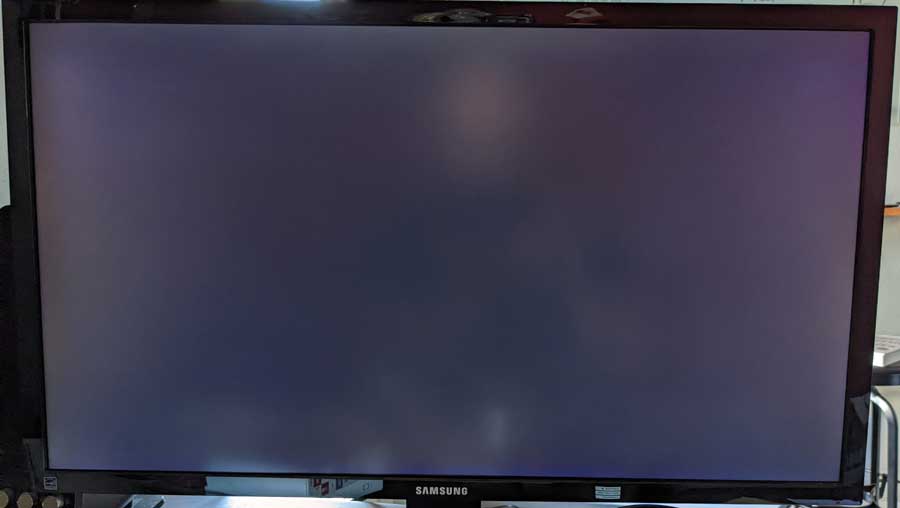Last Updated on June 22, 2023 by Tim Wells
When watching TV, we all want the best colors, brightest lights, and darkest darks. Older TVs can suffer from something called backlight bleed that makes our TVs look worse than they should.
What is backlight bleed, and, more importantly, how do you fix it?
Read on to find out.
What Is Backlight Bleed?
To fix a backlight bleed, you first need to know what a backlight is. Backlights are used in liquid crystal displays (LCD) to illuminate the screen for easier visibility. All LCD screens have backlights because they cannot produce light themselves.
Backlights can be as tiny as a wristwatch or as large as a movie theater screen. Either way, when something goes wrong with your backlight, you notice! The most common issue with backlights is a backlight bleed.
Backlight bleed is relatively standard and happens with most devices at some point. Most of the time, it’s not detrimental to screens and isn’t super noticeable. Still, severe backlight bleeds are, of course, more easily seen.
Backlight bleeds:
- Regularly happen on the edges of a screen
- Look like bright lights peeking through the display
- Can appear in clouds or flashlight-like patterns in the middle of screens
If your display is at 100% brightness, backlight bleed is almost guaranteed to show up.
You should be good to go once you turn your brightness down unless your backlight bleed is exceedingly severe.
Testing for Backlight Bleed
If you’re concerned that you have backlight bleeding or want to figure out how to know for sure, there are a few ways to test your monitor to check.
The easiest way is to turn your brightness down or turn your screen completely off.
Look at the edges of the screen – do you see illumination coming through, or do you see clouds of light at the bottom and top of the screen?
If yes, you probably have a backlight bleed.
Consider whether you have a vertical alignment display, in-plane switching display, or twisted nematic. Backlight bleed can vary in appearance based on the type of display you have.
Backlight Bleed vs. IPS Glow
IPS glow also occurs in in-plane switching displays and is easily confused with backlight bleed. While it looks similar, the IPS glow is slightly different.
IPS glow shows up only in corners, but backlight bleed is visible along the edges of the screen and corners as well.
Another difference is that IPS glow can change in appearance depending on the angle. Backlight bleeds, however, stay relatively stagnant no matter the point of view.
An IPS glow is not an issue with your display.
It’s a problem with your IPS panel and can’t be fixed or remedied the same way as a backlight bleed. IPS glow is a more significant issue.

What Backlight Bleed Looks Like
There are a few different kinds of backlight bleed. Each has differing levels of visibility.
Clouding
This type of backlight bleed is the most noticeable. The primary indicator of clouding is when patches of light are visible on the screen, even when the monitor is off.
The clouds are light grey and vary in size. Most of the time, they aren’t visible in bright light or when the screen is on.
Clouding is also:
- More common on larger displays
- Often due to poor installation
- Usually more visible than other bleeds
Clouding is the most annoying type of backlight bleed because it’s the most disruptive – especially for gaming.
Flashlight
Much more common than clouding is flashlighting, a type of backlight bleed that appears along the edges of displays.
Flashlighting is less of a nuisance because it’s more easily hidden.
Significant flashlighting occurs when a screen with bright corners appears dimmer in the middle during use.
How to Fix Backlight Bleed
Plenty of options exist for improving your backlight bleed disparities and preventing future bleeds.
If you want to purchase a new monitor or anything with an LCD, make sure you buy a decent-quality product. Cheaper monitors have more backlight bleed problems, leading to high repair costs and, eventually, replacement.
It’s better to start with a high-quality monitor with minimal bleeding risk than to buy a cheap one only to repair it shortly after. A cheaply made LCD means you will spend more in the long run.
Maybe you’re already in the trenches with a backlight bleed and don’t have the funds to drop on a pricey new monitor.
Fear not – below are some solutions for backlight bleed!
Adjust Your Brightness
Bright screens are nice to look at, but not ideal for backlight bleeds. Reduce your brightness to a level that’s visible but not at 100%.
This method should work if:
- You have minimal backlight bleeding
- Your screen is small or medium-sized
- Bleeding is more visible on the edges of your display
Adjusting brightness levels won’t work for massive screens or sizable bleeds, but it’s always an option for a quick remedy.
Loosen the Frame
The frame holds your display in place, and sometimes, the screws are too tight.
Screws that are too snug cause backlight bleeding, especially flash lighting. Tight screws also make screens warp and bend, leading to more display issues.
You only need to take a screwdriver and loosen the screws on the frame.
Turn your monitor back on, and your backlight bleed should be slightly reduced.
Clean the LCD
Grease, dirt, and dust all build up in LCD screens after a while, and that can cause backlight bleed.
To clean the LCD panel, use a microfiber cloth and gently wipe wherever you notice the backlight bleed. After that, give your screen a few days to improve. If it doesn’t, try cleaning it again.
Sometimes, the backlight bleed is downright stubborn and won’t go away.
If it doesn’t bother you too much, it’s not detrimental to your device, so feel free to continue to use it. If the backlight bleed drives you crazy, you may want to look into returning your device or replacing the screen.
Curved screens sometimes help delay the onset of backlight bleed, but they’re getting much more challenging to find these days.
Either way, backlight bleed isn’t harmful and won’t ruin screen quality.
- How to Install Kodi Diggz Xenon Plus & Free99 Build [March 2024] - March 3, 2024
- How to Enable Unknown Sources on Chromecast with Google TV [2024] - October 30, 2023
- How to Install the Seren Kodi Addon [2024] - October 29, 2023

